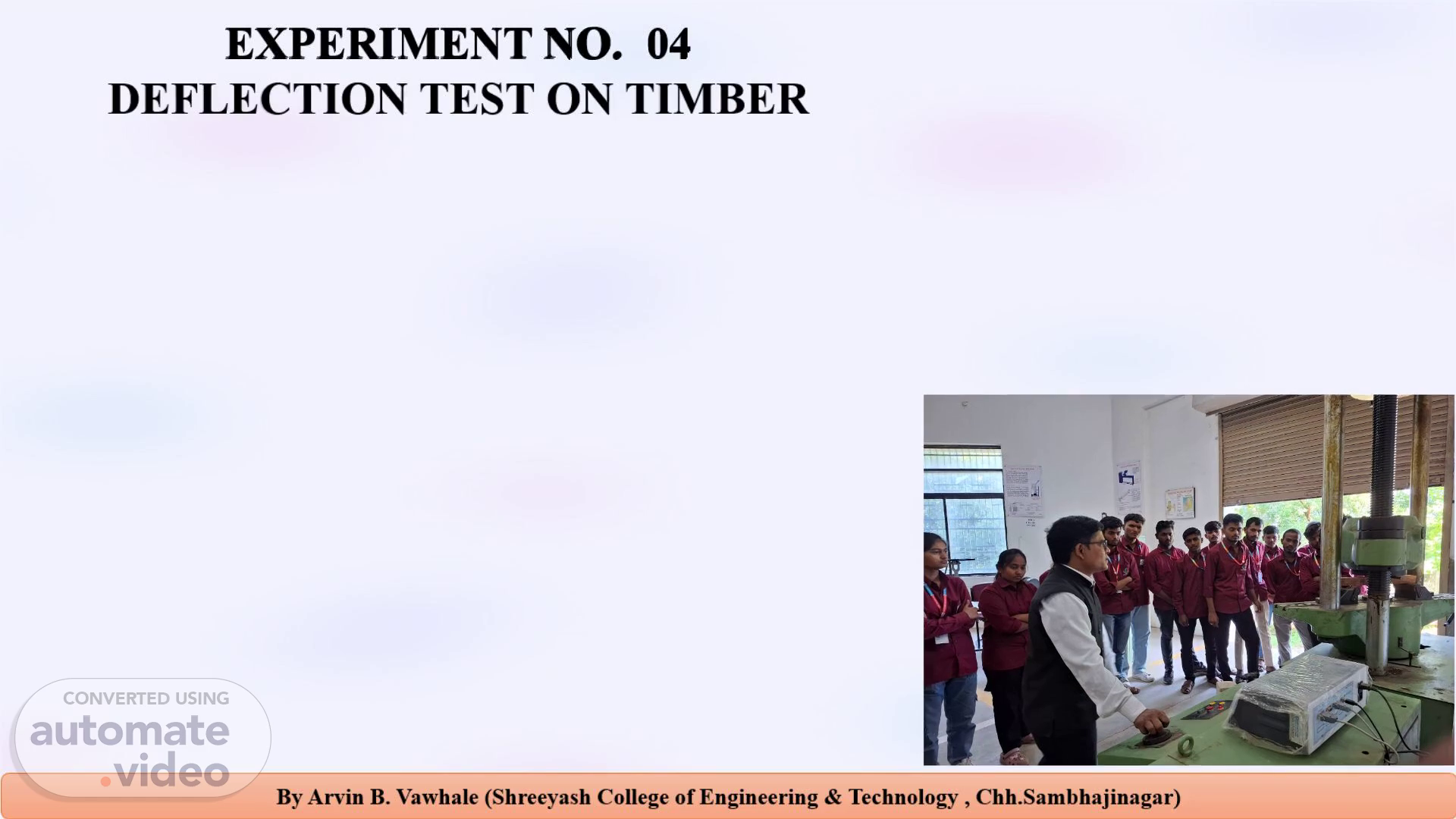Scene 1 (0s)
[Audio] Greetings of the day , In this session we are going to discuss the deflection of wooden beam by using universal testing machine. This practical aims to determine the deflection of the wooden beam by means of theoretically as well as practically. Greetings of the day , In this session we are going to discuss the deflection of wooden beam by using universal testing machine. This practical aims to determine the deflection of the wooden beam by means of theoretically as well as practically..
Scene 2 (31s)
[Audio] EXPERIMENT NUMBER FOUR DEFLECTION TEST ON TIMBER Aim: To determine the Deflection of timber by using universal Testing Machine. APPARATUS: universal Testing Machine, Bending fixture, Meter scale, Wooden beam. REFERENCE: Indian Standard IS 1708 (Part 5):1986, Methods of testing of small clear specimens of timber, Part 5: Determination of static bending strength. Indian Standard IS 516 : Part 1 : Section 1 : 2021 (Hardened concrete methods of test for compressive, flexural and split tensile strength): This is the current, most relevant standard for flexural testing..
Scene 3 (1m 20s)
[Audio] THEORY: Bending test is performing on beam by using the three point loading system. The bending fixture is supported on the platform of hydraulic cylinder of the UTM. The loading is held in the middle cross head. At a particular load the deflection at the center of the beam is determined by using a dial gauge. The deflection at the beam center is given by: Deflection is equal to w into L cube by 48 EI and the unit is 𝑚𝑚 Similarly for a Cantilever is a Beam one end of which is clamped and other end is free. A beam with a length L and is fixed at one end and the other end is free. Let the moment of inertia of the Beam is 'I' about its neutral axis and the Young's Modulus be 'E'. Moment of inertia about the neutral axis Moment of Inertia is equal to b into h cube by 12 and the unit is mm4 Deflection at the end where point load is acting I equal to delta. The deflection at the end (Max deflection) delta is related to the load 'W', length 'L' moment of Inertia 'I' and Young's Modulus 'E' through the equation. Deflection is equal to w into l cube by 3 EI unit is 𝑚𝑚.
Scene 4 (2m 38s)
[Audio] PROCEDURE Measure the length, width and thickness of test piece, by meter scale. Ends Place the bending fixture on the lower cross head of the testing machine. Place the test piece on the rollers of the bending fixture. By loading the dial gauge in a stand, make its spindle knob the test piece. Start the UTM and note down the load and dial gauge readings. Plot the graph between load and deflection. PRECAUTIONS 1. The length of the simply supported should be measured properly. 2. The dial gauge spindle knob should always touch the beam at the bottom of loading point. 3. Loading hanger should be placed at known distance 4. Al the errors should be eliminated while taking readings. 5. Beam should be positioned horizontally..
Scene 5 (3m 28s)
[Audio] This is the observation table in which length of specimen, width of specimen, depth of specimen is given and by applying loading in universal testing machine will get ultimate compressive load and ultimate deflection. All value of the different specimen are given in this table.
Scene 6 (3m 50s)
[Audio] These are the SAMPLE CALCULATION For First reading:- The Young's modulus that is Modulus of Elasticity of babool wood, as per data referenced in an Indian context, is approximately 18.70 Giga Pascal for this we need the Moment of Inertia of wooden beam which is equal to b into d cube divide by 12 unit is mm4 which is equal to 48 into 48 cube by 12 which gives 442.368 into 10 cube mm raise to four Deflection equal to w into l cube by 48 EI unit is 𝑚𝑚 which gives 26.10 into 10 cube multiply by 400 cube divide by 48 into 18700 into 442.368 into 10 cube equal to 4.206 mm (this value calculated Theoretically) and practicall it will be 4.3 mm.
Scene 7 (4m 48s)
[Audio] Similarly for second specimen we get the deflection theoretically is 3.602 mm and practically 4.6 mm.
Scene 8 (4m 58s)
[Audio] And for the third specimen we will get the deflection theoretically is 4.456 mm and practically 4.0 mm.
Scene 9 (5m 8s)
[Audio] Value of Average deflection Theoretically is equal to 4.206 plus 3.602 plus 4.456 by 3 which is equal to 4.088 mm Similarly Value of Average deflection Practically is equal to 4.3 plus 4.6 plus 4.0 by 3 which is equal to 4.30 mm PRECAUTIONS to be taken while performing practical The specimen should be prepared in proper dimensions. The specimen should be properly to get between the compression plates. Reading should be taken carefully. After failed specimen stop to machine. And finally we got RESULT from experiment is The average deflection theoretically of given specimen is equal to 4.088 mm and the average deflection practically of given specimen is equal to 4.30 mm.
